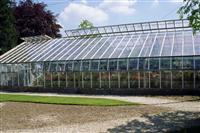
A course for commercial cut flower growers (and staff) who are concerned exclusively with greenhouse production
Flowers are grown in greenhouses for various reasons:
- To produce flowers out of season when prices are better
- To grow varieties that in localities they are not normally suited to
- To produce flowers for a longer season
- To produce flowers faster
- To reduce the likelihood of disease, pest or environmental damage (reduced quality)
Greenhouse production can involve a much larger initial investment, but production can be more intensive (so not as much land is needed) and profitability can eventually be higher.